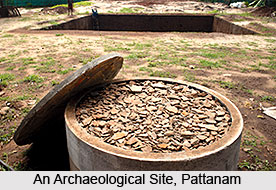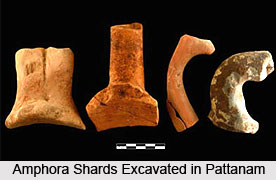 Pattanam village is present in Eranakulam District, close to the Periyar delta in the Indian state of Kerala. It exists at a distance of 9 km from the southern part of Kodungallur, 2 km from the northern portion of North Paravur and 25 km from the northern part of Kochi or Cochin. Latest archaeological explorations at Pattanam have brought to light interesting evidences which point towards the presence of a civilization dating around 1000 BCE, which continued to thrive till 10th century CE.
Pattanam village is present in Eranakulam District, close to the Periyar delta in the Indian state of Kerala. It exists at a distance of 9 km from the southern part of Kodungallur, 2 km from the northern portion of North Paravur and 25 km from the northern part of Kochi or Cochin. Latest archaeological explorations at Pattanam have brought to light interesting evidences which point towards the presence of a civilization dating around 1000 BCE, which continued to thrive till 10th century CE.
History of Pattanam
Periyar Thodu or the Periyar canal, which is a branch of the Periyar River flows through an area which is close to Pattanam. However, some geologists have discovered with the aide of satellite imagery that the delta of Periyar River was existent on the southern side and that this Indian river might have flowed near Pattanam. Besides this, the regional inhabitants of Pattanam have unearthed a vast quantity of broken pottery shards and old fired bricks, when they were digging the ground. All such evidences clearly suggest that the Periyar River might have probably flowed near Pattanam 2000 years ago.
Archaeological Excavations at Pattanam
Activities like sand quarrying have led to the destruction of some of the archaeological sites at Pattanam. AMS 14 C analysis or Accelerator Mass Spectometry process of analysis of wood and charcoal supplies belonging to the Iron Age have determined their age to the first millennium BC. Kerala Council for Historical Research (KCHR) has undertaken the task of multi seasonal archaeological research from 2007. This organization is responsible for a major initiative for carrying our excavations in Kerala. The British Association for South Asian Studies or BASAS has been granted recognition for the creation of a global research group based at Pattanam.  Beautiful square-shaped copper coins, engraved with the symbol of an elephant and an image of bows and arrows on the other side have been excavated from here. It is believed that such coins used to be issued in the earlier part of the Christian era.However, the fact that these artefacts unearthed from Pattanam originally belong to Rome has not been proven properly. Amphora, Chera coins, Cameo Blanks and Terra Sigillatta composed of semi precious stones, glass beads and glass have been dug out, in large numbers. A few remnants of burned bricks and structures manufactured from bricks have also been found from this area. A wharf canoe which is made of `anjili` wood, botanical remains and bollards of teak wood have also been revealed.
Beautiful square-shaped copper coins, engraved with the symbol of an elephant and an image of bows and arrows on the other side have been excavated from here. It is believed that such coins used to be issued in the earlier part of the Christian era.However, the fact that these artefacts unearthed from Pattanam originally belong to Rome has not been proven properly. Amphora, Chera coins, Cameo Blanks and Terra Sigillatta composed of semi precious stones, glass beads and glass have been dug out, in large numbers. A few remnants of burned bricks and structures manufactured from bricks have also been found from this area. A wharf canoe which is made of `anjili` wood, botanical remains and bollards of teak wood have also been revealed.
Marvellous pendants, beads of glass and stone, coins marked with figures of elephants and bows and arrows, cameo banks, objects composed of copper, iron and rarely of gold, pottery-ware belonging to India and overseas. A damaged rim embedded with Brahmi script, which is said to be the oldest pottery inscription which has been found at the village of Pattanam. Various forms of pottery works belonging to prehistoric age, which can be traced back to the 1st century A.D. have also been uncovered. Excavations conducted during the year 2011, have also revealed the presence of Chola coins, copper nails, terracotta, semi precious stone beads, iron nails and Roman glass.






































